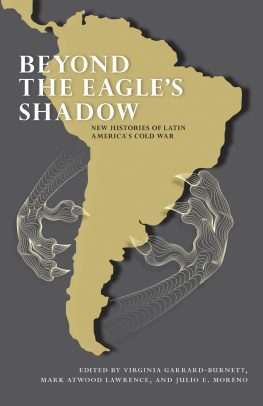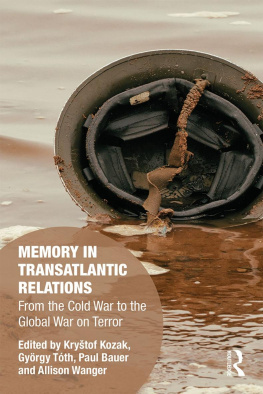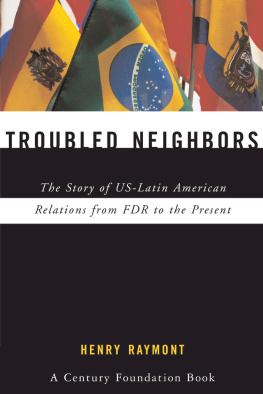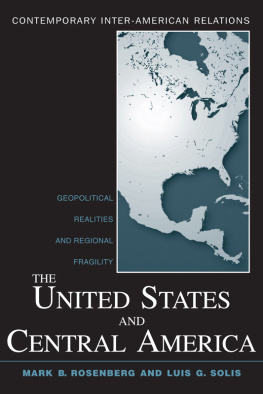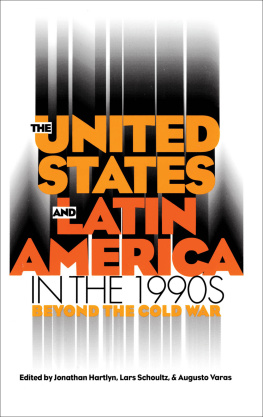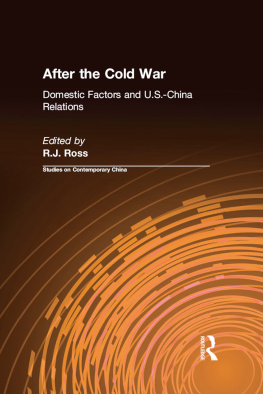BEYOND THE EAGLES SHADOW
BEYOND THE EAGLES SHADOW
New Histories of Latin Americas Cold War
EDITED BY VIRGINIA GARRARD-BURNETT,
MARK ATWOOD LAWRENCE,
AND JULIO E. MORENO
2013 by the University of New Mexico Press
All rights reserved. Published 2013
Printed in the United States of America
18 17 16 15 14 13 1 2 3 4 5 6
The Library of Congress has cataloged the printed edition as follows:
Beyond the eagles shadow : new histories of Latin Americas cold war / edited by
Virginia Garrard-Burnett, Mark Atwood Lawrence, and Julio E. Moreno.
pages cm
Includes index.
ISBN 978-0-8263-5368-9 (hardback) ISBN 978-0-8263-5369-6 (ebook)
1. Latin AmericaPolitics and government19481980. 2. Latin AmericaPolitics and government1980 3. Cold WarPolitical aspectsLatin America. 4. Cold WarSocial aspectsLatin America. I. Garrard-Burnett, Virginia, 1957 editor of compilation. II. Lawrence, Mark Atwood, editor of compilation. III. Moreno, Julio, 1970 author, editor of compilation.
F1414.2.B46 2013
980.03dc23
2013017211
Contents
Virginia Garrard-Burnett, Mark Atwood Lawrence, and Julio E. Moreno
JULIO E. MORENO
GIOVANNI BATZ
ARAGORN STORM MILLER
JONATHAN C. BROWN
RENATA KELLER
SETH GARFIELD
JAMES JENKINS
K. CHEASTY ANDERSON
JENNIFER T. HOYT
BONAR L. HERNNDEZ
MICHELLE DENISE REEVES
ALAN MCPHERSON
Preface
ONE OF THE MOST EXCITING FEATURES OF STUDYING THE HISTORY OF the Cold War is the abundant opportunity for collaboration. At some level, of course, collaborative work is imperative in order to understand the Cold War in all its complexity. The East-West conflict touched every part of the world, after all, and affected all dimensions of human existencenot just geopolitics and military affairs but also the ideological, social, and cultural realms. No single scholar could hope even to come close to mastering everything. But collaboration is useful for another reason, too: The sheer pleasure of working with peers, exchanging ideas, and building a whole that is greater than the sum of its parts.
We editors are grateful to our contributors as well as to numerous individuals who have helped in various ways over the years as this project grew from an idea to a book proposal to a published collection. In the UTAustin Department of History, we particularly thank the Institute for Historical Studies and its energetic and generous director, Julie Hardwick, who provided crucial support that moved us beyond the idea stage. Thanks go as well to Courtney Meador, who helped in innumerable ways with her signature combination of efficiency and generosity. The departments senior Latin Americanist, Jonathan Brown, also deserves a word of special gratitude for encouraging us to pursue this volume. Creighton Chandler provided invaluable help in the closing stages.
We are indebted in innumerable ways to all of our colleagues at UTAustin and the University of San Francisco and thank them for the encouragement they have shown for our work. Ginny Burnett wishes to acknowledge in particular her graduate students, without whose efforts and enthusiasm this project could not have been completed. Mark Lawrence wishes to thank the Stanley Kaplan Program in American Foreign Policy at Williams College, which provided a wonderful temporary home during the 201112 academic year, and especially the programs director, James McAllister. Julio Moreno thanks the Faculty Development Fund at the University of San Francisco. He is particularly grateful to Julie Hardwick and Courtney Meador at UTAustins Institute for Historical Studies for providing a supportive and intellectually stimulating environment in the 20092010 academic year.
Finally, we all express our deepest thanks to W. Clark Whitehorn, editor-in-chief for the University of New Mexico Press. Clark showed enthusiasm from the moment we first described the project and shepherded the book to completion with a wonderful blend of efficiency, expertise, and good cheer. Thanks go as well to two anonymous reviewers, whose comments made this a better book in innumerable ways.
Introduction
VIRGINIA GARRARD-BURNETT,
MARK ATWOOD LAWRENCE, AND JULIO E. MORENO
IT ALL STARTED WITH REBELLIOUS TEENAGERS. ON JANUARY 7, 1964, American students ran the U.S. flag up a flagpole on the grounds of Balboa High School, near the western end of the Panama Canal Zone. The gesture was intensely provocative. The question of where the U.S. and Panamanian flags could be flown in the canal zone had stirred controversy for several years, reflecting growing tensions between Americans and Panamanians over sovereignty in the ten-mile-wide strip of territory that the United States had controlled for more than sixty years. In late 1963, the U.S. governor of the canal zone had tried to defuse the situation by declaring that neither flag would fly over schools or other civic buildings. But the ploy backfired. Outraged by what they considered a cave in to Panamanian pressure, the Balboa students, backed by many parents and other Zonians, took matters into their own hands.
Predictably, Panamanian high schoolers quickly retaliated. On January 9, 150 students from the nearby Instituto Nacional marched to Balboa High and attempted to fly their flag alongside the stars and stripes. Scuffling ensued. The Panamanian flag was torn. Word of the incident spread and, by nightfall, rioting had broken out along the borders of the canal zone, where thousands of U.S. troops were mobilized to safeguard the waterway. When the unrest ended three days later, twenty-one Panamanians and four U.S. soldiers lay dead. Panamanian President Roberto Chiari severed relations with the United States, demanding that Washington agree to scrap the old treaties governing control over the canal and negotiate a new deal.
This assessment was, as U.S. leaders soon came to realize, wildly off the mark. While leftists no doubt sought to exploit the unrest, the Panamanian communist party remained small and ineffective. The rioting and the diplomatic confrontation that ensued resulted from deep anger across the Panamanian political spectrum about treaties viewed as a grotesque remnant of U.S. quasi-colonialism in the days of Teddy Roosevelt. Indeed, as negotiations opened to restore diplomatic relations and ultimately to rewrite the canal treaties, leftists played no important role outside of stirring fear among Americans. Rather, Chiari and his successor Marco Roblesboth of them representative of the conservative, land-owning oligarchy that ruled Panamajoined in various ways with the repressive National Guard and corporate leaders such as the head of the local Coca-Cola Company to play the key roles in advancing Panamanian demands. When Washington agreed at the end of 1964 to renegotiate the canal treaties, the Panamanian foreign minister rejoiced that the concession, far from emboldening the left, would send the communists al carajoto hell.
The flag riots and their aftermath neatly illuminate the complexities of the Cold War in Latin America. Observers, especially in the United States, readily viewed the confrontation through the lens of the East-West struggle. They were not, of course, entirely wrong to do so. Although Panamanian, Cuban, and Soviet sources remain mostly inaccessible, it is not difficult to imagine that communists and Castroites inside and outside of Panama sought to exploit the clash to serve their larger goals. Yet the episode in Panama was no simple proxy confrontation between the democratic-capitalist West and the communist East. The crisis originated, after all, with teenagers acting on nationalist impulses rooted in grievances that long predated the Cold War. The mundane location of the flagpole confrontation suggests that hostilities sprang from tensions woven into everyday life for demonstrators on both sides of the issue, not from the dictates of distant superpowers. Perhaps the most striking feature of the crisis, however, was the extent to which Washington found itself sharply at odds with centrist and even right-wing elements in Panama, the very groups that shared U.S. anxiety about communism in Panama and the hemisphere more generally. Indeed, Johnsons decision in December 1964 to open negotiations on new canal treatiesa watershed moment in U.S.Latin American relationsreflected his ultimate judgment that the confrontation did not break down along simple Cold War lines. The United States stood to gain, Johnson concluded, by making concessions to conservative elements rather than standing firm and thereby risking the very leftist hostility that Americans so desperately feared.

